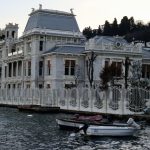Osman Hamdi was born in İstanbul in 1842, the son of İbrahim Erdhem Pasa, a man important enough to have briefly held the post of grand vizier to Sultan Abdülhamid II.
Osman duly studied law first in İstanbul and then in Paris. Although obviously intended for a career in the Ottoman civil service, he was soon dabbling in art, which didn’t stop him from being despatched to work in Baghdad for a while. It wasn’t until 1881, when he became director of the Imperial Museum, that his life began to take the shape he must have longed for.
A keen archaeologist, Osman Hamdi Bey worked on the hugely significant excavations for the Commagene remains on Mt Nemrut; on the dig for the temple dedicated to Hecate at Lagina near Milas; and then at Sidon in Lebanon, which was part of the Ottoman Empire at that time. There he helped uncover the magnificent 4th-century BC Sarcophagus of Alexander and a number of other tombs in the royal necropolis and arranged to have them transported to İstanbul. Not satisfied with this, he then worked tirelessly to have the İstanbul Archaeological Museum built to house the finds; its doors finally opened in 1891. Alarmed at the flow of invaluable archaeological treasures out of the country under one flimsy pretext or another, he also helped to get a law passed that forbade the smuggling of antiquities, the precursor to the law that still applies today.
With the passing of the years Osman became more enthusiastic about his art, painting what is probably his most famous and enigmatic work, The Tortoise Trainer, in 1907. Today it’s on display in the Pera Museum on Meşrutiyet Caddesi in Tepebaşı in İstanbul.
A family man, he married twice and had several children, living with them in Kuruçeşme in the winter (oddly, the site of his yalı hasn’t been precisely identified) and in Eskihisar in the summer. There he owned a lovely wooden yalı (waterside mansion) which was opened to the public as a museum in 1982.
Amongst his other achievements Osman Hamdi Bey served as the first mayor of Kadıköy. He died in İstanbul in 1910 and is buried in the cemetery in Eskihisar.


